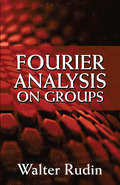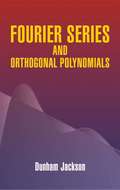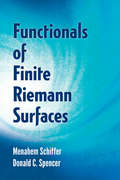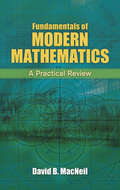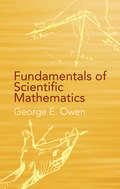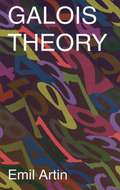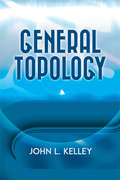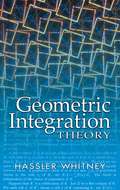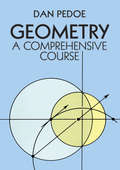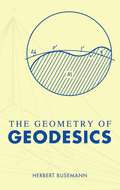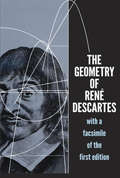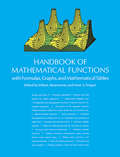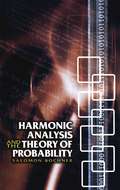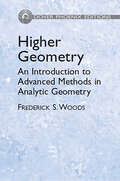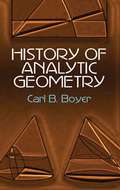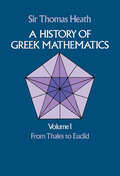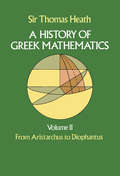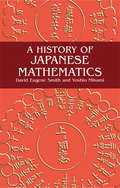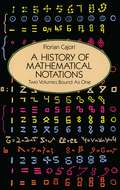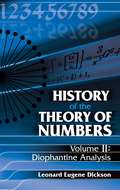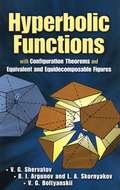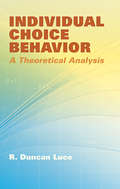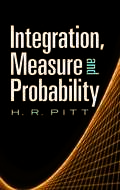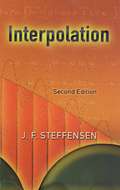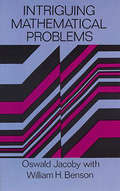- Table View
- List View
Fourier Analysis on Groups (Dover Books on Mathematics)
by Walter RudinWritten by a master mathematical expositor, this classic text reflects the results of the intense period of research and development in the area of Fourier analysis in the decade preceding its first publication in 1962. The enduringly relevant treatment is geared toward advanced undergraduate and graduate students and has served as a fundamental resource for more than five decades.The self-contained text opens with an overview of the basic theorems of Fourier analysis and the structure of locally compact Abelian groups. Subsequent chapters explore idempotent measures, homomorphisms of group algebras, measures and Fourier transforms on thin sets, functions of Fourier transforms, closed ideals in L1(G), Fourier analysis on ordered groups, and closed subalgebras of L1(G). Helpful Appendixes contain background information on topology and topological groups, Banach spaces and algebras, and measure theory.
Fourier Series and Orthogonal Polynomials: The Carus Mathematical Monographs, No. 6
by Dunham JacksonThis text for undergraduate and graduate students illustrates the fundamental simplicity of the properties of orthogonal functions and their developments in related series. Starting with a definition and explanation of the elements of Fourier series, the text follows with examinations of Legendre polynomials and Bessel functions. Boundary value problems consider Fourier series in conjunction with Laplace's equation in an infinite strip and in a rectangle, with a vibrating string, in three dimensions, in a sphere, and in other circumstances. An overview of Pearson frequency functions is followed by chapters on orthogonal, Jacobi, Hermite, and Laguerre polynomials, and the text concludes with a chapter on convergence. 1941 edition.
Functionals of Finite Riemann Surfaces
by Menahem Schiffer Donald C. SpencerThis advanced monograph on finite Riemann surfaces, based on the authors' 1949-50 lectures at Princeton University, remains a fundamental book for graduate students. Suitable for graduate-level courses, the text begins with three chapters that offer a development of the classical theory along historical lines, examining geometrical and physical considerations, existence theorems for finite Riemann surfaces, and relations between differentials. Subsequent chapters explore bilinear differentials, surfaces imbedded in a given surface, integral operators, and variations of surfaces and of their functionals. The book concludes with a look at applications of the variational method and remarks on generalization to higher dimensional Kahler manifolds.
Fundamentals of Modern Mathematics: A Practical Review (Dover Books on Mathematics)
by David B. MacNeilStudents and others wishing to know a little more about the practical side of mathematics will find this volume a highly informative resource. An excellent supplement to college and high school courses as well as a guide to independent study, the book covers examples of pure mathematics as well as concepts of applied mathematics useful for solving problems that arise in business, industry, science, and technology.Contents include examinations of the theory of sets, numbers and groups; matrices and determinants; probability, statistics, and quality control; and game theory. Additional subjects include inequalities, linear programming, and the transportation problem; combinatorial mathematics; transformations and transforms; and numerical analysis. Accessible explanations of important concepts feature a total of more than 150 diagrams and graphs, in addition to worked-out examples with step-by-step explanations of methods. Answers to exercises and problems appear at the end.
Fundamentals of Scientific Mathematics (Dover Books on Mathematics)
by George E. OwenThis rewarding text, beautifully illustrated by the author and written with superb clarity, offers undergraduate students a solid mathematical background and functions equally well for independent study.The five-part treatment begins with geometry, defining three-dimensional Euclidean space and its axioms, the coordinate system and coordinate transformation, and matrices. A review of vector algebra covers vector properties, multiplication, the resolution of a vector along a complete set of base vectors, and vector transformations. Topics in analytic geometry introduce loci, straight lines, the plane, two-dimensional curves, and the quadratic form. Functions are defined, as are intervals, along with multiplicity, the slope at a point, continuity, and areas. The concluding chapter, on differential and integral calculus, explains the concept of a limit, the derivative, the integral, differential equations, and applications of the calculus to kinematics.
Galois Theory (Dover Books on Mathematics)
by Arthur N. Milgram Emil ArtinIn the nineteenth century, French mathematician Evariste Galois developed the Galois theory of groups-one of the most penetrating concepts in modem mathematics. The elements of the theory are clearly presented in this second, revised edition of a volume of lectures delivered by noted mathematician Emil Artin. The book has been edited by Dr. Arthur N. Milgram, who has also supplemented the work with a Section on Applications.The first section deals with linear algebra, including fields, vector spaces, homogeneous linear equations, determinants, and other topics. A second section considers extension fields, polynomials, algebraic elements, splitting fields, group characters, normal extensions, roots of unity, Noether equations, Jummer's fields, and more.Dr. Milgram's section on applications discusses solvable groups, permutation groups, solution of equations by radicals, and other concepts.
General Topology (Dover Books on Mathematics)
by John L. Kelley"The clarity of the author's thought and the carefulness of his exposition make reading this book a pleasure," noted the Bulletin of the American Mathematical Society upon the 1955 publication of John L. Kelley's General Topology. This comprehensive treatment for beginning graduate-level students immediately found a significant audience, and it remains a highly worthwhile and relevant book for students of topology and for professionals in many areas. A systematic exposition of the part of general topology that has proven useful in several branches of mathematics, this volume is especially intended as background for modern analysis. An extensive preliminary chapter presents mathematical foundations for the main text. Subsequent chapters explore topological spaces, the Moore-Smith convergence, product and quotient spaces, embedding and metrization, and compact, uniform, and function spaces. Each chapter concludes with an abundance of problems, which form integral parts of the discussion as well as reinforcements and counter examples that mark the boundaries of possible theorems. The book concludes with an extensive index that provides supplementary material on elementary set theory.
Geometric Integration Theory
by Hassler WhitneyGeared toward upper-level undergraduates and graduate students, this treatment of geometric integration theory consists of three parts: an introduction to classical theory, a postulational approach to general theory, and a final section that continues the general study with Lebesgue theory.The introductory chapter shows how the simplest hypotheses lead to the employment of basic tools. The opening third of the treatment, an examination of classical theory, leads to the theory of the Riemann integral and includes a study of smooth (i.e., differentiable) manifolds. The second part, on general theory, explores abstract integration theory, some relations between chains and functions, general properties of chains and cochains, and chains and cochains in open sets. The third and final section surveys Lebesgue theory in terms of flat cochains and differential forms, Lipschitz mappings, and chains and additive set functions. Appendixes on vector and linear spaces, geometric and topological preliminaries, and analytical preliminaries, along with indexes of symbols and terms, conclude the text.
Geometry: A Comprehensive Course
by Dan Pedoe"A lucid and masterly survey." — Mathematics GazetteProfessor Pedoe is widely known as a fine teacher and a fine geometer. His abilities in both areas are clearly evident in this self-contained, well-written, and lucid introduction to the scope and methods of elementary geometry. It covers the geometry usually included in undergraduate courses in mathematics, except for the theory of convex sets. Based on a course given by the author for several years at the University of Minnesota, the main purpose of the book is to increase geometrical, and therefore mathematical, understanding and to help students enjoy geometry.Among the topics discussed: the use of vectors and their products in work on Desargues' and Pappus' theorem and the nine-point circle; circles and coaxal systems; the representation of circles by points in three dimensions; mappings of the Euclidean plane, similitudes, isometries, mappings of the inversive plane, and Moebius transformations; projective geometry of the plane, space, and n dimensions; the projective generation of conics and quadrics; Moebius tetrahedra; the tetrahedral complex; the twisted cubic curve; the cubic surface; oriented circles; and introduction to algebraic geometry.In addition, three appendices deal with Euclidean definitions, postulates, and propositions; the Grassmann-Pluecker coordinates of lines in S3, and the group of circular transformations. Among the outstanding features of this book are its many worked examples and over 500 exercises to test geometrical understanding.
The Geometry of Geodesics
by Herbert BusemannA comprehensive approach to qualitative problems in intrinsic differential geometry, this text for upper-level undergraduates and graduate students emphasizes cases in which geodesics possess only local uniqueness properties--and consequently, the relations to the foundations of geometry are decidedly less relevant, and Finsler spaces become the principal subject.This direct approach has produced many new results and has materially generalized many known phenomena. Author Herbert Busemann begins with an explanation of the basic concepts, including compact metric spaces, convergence of point sets, motion and isometry, segments, and geodesics. Subsequent topics include Desarguesian spaces, with discussions of Riemann and Finsler spaces and Beltrami's theorem; perpendiculars and parallels, with examinations of higher-dimensional Minkowskian geometry and the Minkowski plane; and covering spaces, including locally isometric space, the universal covering space, fundamental sets, free homotopy and closed geodesics, and transitive geodesics on surfaces of higher genus. Concluding chapters explore the influence of the sign of the curvature on the geodesics, and homogenous spaces, including those with flat bisectors.
The Geometry of René Descartes: with a Facsimile of the First Edition
by René DescartesThis is an unabridged republication of the definitive English translation of one of the very greatest classics of science. Originally published in 1637, it has been characterized as "the greatest single step ever made in the progress of the exact sciences" (John Stuart Mill); as a book which "remade geometry and made modern geometry possible" (Eric Temple Bell). It "revolutionized the entire conception of the object of mathematical science" (J. Hadamard).With this volume Descartes founded modern analytical geometry. Reducing geometry to algebra and analysis and, conversely, showing that analysis may be translated into geometry, it opened the way for modern mathematics. Descartes was the first to classify curves systematically and to demonstrate algebraic solution of geometric curves. His geometric interpretation of negative quantities led to later concepts of continuity and the theory of function. The third book contains important contributions to the theory of equations.This edition contains the entire definitive Smith-Latham translation of Descartes' three books: Problems the Construction of which Requires Only Straight Lines and Circles; On the Nature of Curved Lines; and On the Construction of Solid and Supersolid Problems. Interleaved page by page with the translation is a complete facsimile of the 1637 French text, together with all Descartes' original illustrations; 248 footnotes explain the text and add further bibliography.
Handbook of Mathematical Functions: with Formulas, Graphs, and Mathematical Tables
by Milton Abramowitz Irene A. StegunDespite the increasing use of computers, the basic need for mathematical tables continues. Tables serve a vital role in preliminary surveys of problems before programming for machine operation, and they are indispensable to thousands of engineers and scientists without access to machines. Because of automatic computers, however, and because of recent scientific advances, a greater variety of functions and a higher accuracy of tabulation than have been available until now are required.In 1954, a conference on mathematical tables, sponsored by M.I.T. and the National Science Foundation, met to discuss a modernization and extension of Jahnke and Emde's classical tables of functions. This volume, published 10 years later by the U.S. Department of Commerce, is the result. Designed to include a maximum of information and to meet the needs of scientists in all fields, it is a monumental piece of work, a comprehensive and self-contained summary of the mathematical functions that arise in physical and engineering problems.The book contains 29 sets of tables, some to as high as 20 places: mathematical constants; physical constants and conversion factors (6 tables); exponential integral and related functions (7); error function and Fresnel integrals (12); Bessel functions of integer (12) and fractional (13) order; integrals of Bessel functions (2); Struve and related functions (2); confluent hypergeometric functions (2); Coulomb wave functions (2); hypergeometric functions; Jacobian elliptic and theta functions (2); elliptic integrals {9); Weierstrass elliptic and related functions; parabolic cylinder functions {3); Mathieu functions (2); spheroidal wave functions (5); orthogonal polynomials (13); combinatorial analysis (9); numerical interpolation, differentiation and integration (11); probability functions (ll); scales of notation (6); miscellaneous functions (9); Laplace transforms (2); and others.Each of these sections is prefaced by a list of related formulas and graphs: differential equations, series expansions, special functions, and other basic relations. These constitute an unusually valuable reference work in themselves. The prefatory material also includes an explanation of the numerical methods involved in using the tables that follow and a bibliography. Numerical examples illustrate the use of each table and explain the computation of function values which lie outside its range, while the editors' introduction describes higher-order interpolation procedures. Well over100 figures illustrate the text.In all, this is one of the most ambitious and useful books of its type ever published, an essential aid in all scientific and engineering research, problem solving, experimentation and field work. This low-cost edition contains every page of the original government publication.
Harmonic Analysis and the Theory of Probability (Dover Books on Mathematics)
by Salomon BochnerNineteenth-century studies of harmonic analysis were closely linked with the work of Joseph Fourier on the theory of heat and with that of P. S. Laplace on probability. During the 1920s, the Fourier transform developed into one of the most effective tools of modern probabilistic research; conversely, the demands of the probability theory stimulated further research into harmonic analysis.Mathematician Salomon Bochner wrote a pair of landmark books on the subject in the 1930s and 40s. In this volume, originally published in 1955, he adopts a more probabilistic view and emphasizes stochastic processes and the interchange of stimuli between probability and analysis. Non-probabilistic topics include Fourier series and integrals in many variables; the Bochner integral; the transforms of Plancherel, Laplace, Poisson, and Mellin; applications to boundary value problems, to Dirichlet series, and to Bessel functions; and the theory of completely monotone functions.The primary significance of this text lies in the last two chapters, which offer a systematic presentation of an original concept developed by the author and partly by LeCam: Bochner's characteristic functional, a Fourier transform on a Euclidean-like space of infinitely many dimensions. The characteristic functional plays a role in stochastic processes similar to its relationship with numerical random variables, and thus constitutes an important part of progress in the theory of stochastic processes.
Higher Geometry: An Introduction to Advanced Methods in Analytic Geometry
by Frederick S. WoodsFor students of mathematics with a sound background in analytic geometry and some knowledge of determinants, this volume has long been among the best available expositions of advanced work on projective and algebraic geometry. Developed from Professor Woods' lectures at the Massachusetts Institute of Technology, it bridges the gap between intermediate studies in the field and highly specialized works.With exceptional thoroughness, it presents the most important general concepts and methods of advanced algebraic geometry (as distinguished from differential geometry). It offers a thorough study of one-, two-, three-, and four-dimensional coordinated systems, the concepts they entail, and their associated geometrical elements. This study culminates with a discussion of n-dimensional geometry in an abstract sense, of which the earlier subjects form concrete illustrations.As each system of coordinates is introduced, the meaning of the linear and quadratic equations is studied, with principal emphasis on the interpretation of equations as well as on a knowledge of useful geometrical facts. The principle of duality is kept at the forefront, and the nature of imaginary elements and the conventional character of the locus of infinity, dependent upon the type of coordinates used, are carefully explained.
History of Analytic Geometry: Its Development From The Pyramids To The Heroic Age (Dover Books on Mathematics)
by Carl B. BoyerSpecifically designed as an integrated survey of the development of analytic geometry, this classic study takes a unique approach to the history of ideas. The author, a distinguished historian of mathematics, presents a detailed view of not only the concepts themselves, but also the ways in which they extended the work of each generation, from before the Alexandrian Age through the eras of the great French mathematicians Fermat and Descartes, and on through Newton and Euler to the "Golden Age," from 1789 to 1850. Appropriate as an undergraduate text, this history is accessible to any mathematically inclined reader. 1956 edition. Analytical bibliography. Index.
A History of Greek Mathematics, Volume I: From Thales to Euclid
by Thomas Heath"As it is, the book is indispensable; it has, indeed, no serious English rival." — Times Literary Supplement. "Sir Thomas Heath, foremost English historian of the ancient exact sciences in the twentieth century." — Professor W. H. Stahl"Indeed, seeing that so much of Greek is mathematics, it is arguable that, if one would understand the Greek genius fully, it would be a good plan to begin with their geometry." The perspective that enabled Sir Thomas Heath to understand the Greek genius — deep intimacy with languages, literatures, philosophy, and all the sciences — brought him perhaps closer to his beloved subjects and to their own ideal of educated men, than is common or even possible today. Heath read the original texts with a critical, scrupulous eye, and brought to this definitive two-volume history the insights of a mathematician communicated with the clarity of classically taught English. "Of all the manifestations of the Greek genius none is more impressive and even awe-inspiring than that which is revealed by the history of Greek mathematics." Heath records that history with the scholarly comprehension and comprehensiveness that marks this work as obviously classic now as when it first appeared in 1921. The linkage and unity of mathematics and philosophy suggest the outline for the entire history. Heath covers in sequence Greek numerical notation, Pythagorean arithmetic, Thales and Pythagorean geometry, Zeno, Plato, Euclid, Aristarchus, Archimedes, Apollonius, Hipparchus and trigonometry, Ptolemy, Heron, Pappus, Diophantus of Alexandria and the algebra. Interspersed are sections devoted to the history and analysis of famous problems: squaring the circle, angle trisection, duplication of the cube, and an appendix on Archimedes' proof of the subtangent property of a spiral. The coverage is everywhere thorough and judicious; but Heath is not content with plain exposition: It is a defect in the existing histories that, while they state generally the contents of, and the main propositions proved in, the great treatises of Archimedes and Apollonius, they make little attempt to describe the procedure by which the results are obtained. I have therefore taken pains, in the most significant cases, to show the course of the argument in sufficient detail to enable a competent mathematician to grasp the method used and to apply it, if he will, to other similar investigations. Mathematicians, then, will rejoice to find Heath back in print and accessible after many years. Historians of Greek culture and science can renew acquaintance with a standard reference; readers in general will find, particularly in the energetic discourses on Euclid and Archimedes, exactly what Heath means by impressive and awe-inspiring.
A History of Greek Mathematics, Volume II: From Aristarchus to Diophantus
by Thomas HeathThe perspective that enabled Sir Thomas Heath to understand the Greek genius — deep intimacy with languages, literatures, philosophy, and all the sciences — brought him perhaps closer to his beloved subjects, and to their own ideal of educated men than is common or even possible today. Heath read the original texts with a critical, scrupulous eye and brought to this definitive two-volume history the insights of a mathematician communicated with the clarity of classically taught English."Of all the manifestations of the Greek genius none is more impressive and even awe-inspiring than that which is revealed by the history of Greek mathematics." Heath records that history with the scholarly comprehension and comprehensiveness that marks this work as obviously classic now as when it first appeared in 1921. The linkage and unity of mathematics and philosophy suggest the outline for the entire history. Heath covers in sequence Greek numerical notation, Pythagorean arithmetic, Thales and Pythagorean geometry, Zeno, Plato, Euclid, Aristarchus, Archimedes, Apollonius, Hipparchus and trigonometry, Ptolemy, Heron, Pappus, Diophantus of Alexandria and the algebra. Interspersed are sections devoted to the history and analysis of famous problems: squaring the circle, angle trisection, duplication of the cube, and an appendix on Archimedes's proof of the subtangent property of a spiral. The coverage is everywhere thorough and judicious; but Heath is not content with plain exposition: It is a defect in the existing histories that, while they state generally the contents of, and the main propositions proved in, the great treatises of Archimedes and Apollonius, they make little attempt to describe the procedure by which the results are obtained. I have therefore taken pains, in the most significant cases, to show the course of the argument in sufficient detail to enable a competent mathematician to grasp the method used and to apply it, if he will, to other similar investigations.Mathematicians, then, will rejoice to find Heath back in print and accessible after many years. Historians of Greek culture and science can renew acquaintance with a standard reference; readers in general will find, particularly in the energetic discourses on Euclid and Archimedes, exactly what Heath means by impressive and awe-inspiring.
A History of Japanese Mathematics (Dover Books on Mathematics)
by David E. Smith Yoshio MikamiOne of the first books to show Westerners the nature of Japanese mathematics, this survey highlights the leading features in the development of the wasan, the Japanese system of mathematics. Topics include the use of the soroban, or abacus; the application of sangi, or counting rods, to algebra; the discoveries of the 17th-century sage Seki Kowa; the yenri, or circle principle; the work of 18th-century geometer Ajima Chokuyen; and Wada Nei's contributions to the understanding of hypotrochoids. Unabridged republication of the classic 1914 edition. 74 figures. Index.
A History of Mathematical Notations: Two Volumes Bound as One
by Florian CajoriThis classic study notes the first appearance of a mathematical symbol and its origin, the competition it encountered, its spread among writers in different countries, its rise to popularity, its eventual decline or ultimate survival. The author's coverage of obsolete notations -- and what we can learn from them -- is as comprehensive as those which have survived and still enjoy favor. Originally published in 1929 in a two-volume edition, this monumental work is presented here in one volume.
History of the Theory of Numbers, Volume II: Diophantine Analysis
by Leonard Eugene DicksonThe three-volume series History of the Theory of Numbers is the work of the distinguished mathematician Leonard Eugene Dickson, who taught at the University of Chicago for four decades and is celebrated for his many contributions to number theory and group theory. This second volume in the series, which is suitable for upper-level undergraduates and graduate students, is devoted to the subject of diophantine analysis. It can be read independently of the preceding volume, which explores divisibility and primality, and volume III, which examines quadratic and higher forms.Featured topics include polygonal, pyramidal, and figurate numbers; linear diophantine equations and congruences; partitions; rational right triangles; triangles, quadrilaterals, and tetrahedra; the sums of two, three, four, and n squares; the number of solutions of quadratic congruences in n unknowns; Liouville's series of eighteen articles; the Pell equation; squares in arithmetical or geometrical progression; equations of degrees three, four, and n; sets of integers with equal sums of like powers; Waring's problem and related results; Fermat's last theorem; and many other related subjects. Indexes of authors cited and subjects appear at the end of the book.
Hyperbolic Functions with Configuration Theorems and Equivalent and Equidecomposable Figures
by V. G. Shervatov B. I. Argunov L. A. Skornyakov V. G. BoltyanskiiThis single-volume compilation of three books centers on Hyperbolic Functions, an introduction to the relationship between the hyperbolic sine, cosine, and tangent, and the geometric properties of the hyperbola. The development of the hyperbolic functions, in addition to those of the trigonometric (circular) functions, appears in parallel columns for comparison. A concluding chapter introduces natural logarithms and presents analytic expressions for the hyperbolic functions.The second book, Configuration Theorems, requires only the most elementary background in plane and solid geometry. It discusses several interesting theorems on collinear points and concurrent lines, showing their applications to several practical geometric problems, and thus introducing certain fundamental concepts of projective geometry. Equivalent and Equidecomposable Figures, the final book, discusses the mathematical conditions of dissecting a given polyhedron into a finite number of pieces and reassembling them into another given polyhedron.
Individual Choice Behavior: A Theoretical Analysis (Dover Books on Mathematics)
by R. Duncan LuceThis influential treatise presents upper-level undergraduates and graduate students with a mathematical analysis of choice behavior. It begins with the statement of a general axiom upon which the rest of the book rests; the following three chapters, which may be read independently of each other, are devoted to applications of the theory to substantive problems: psychophysics, utility, and learning.Applications to psychophysics include considerations of time- and space-order effects, the Fechnerian assumption, the power law and its relation to discrimination data, interaction of continua, discriminal processes, signal detectability theory, and ranking of stimuli. The next major theme, utility theory, features unusual results that suggest an experiment to test the theory. The final chapters explore learning-related topics, analyzing the stochastic theories of learning as the basic approach—with the exception that distributions of response strengths are assumed to be transformed rather than response probabilities. The author arrives at three classes of learning operators, both linear and nonlinear, and the text concludes with a useful series of appendixes.
Integration, Measure and Probability
by H. R. PittThis text provides undergraduate mathematics students with an introduction to the modern theory of probability as well as the roots of the theory's mathematical ideas and techniques. Centered around the concept of measure and integration, the work is applicable to other branches of analysis and explores more specialized topics, including convergence theorems and random sequences and functions. 1963 edition.
Interpolation (Dover Books on Mathematics)
by J. F. SteffensenIn the mathematical subfield of numerical analysis, interpolation is a procedure that assists in "reading between the lines" in a set of tables by constructing new data points from existing points. This rigorous presentation employs only formulas for which it is possible to calculate error limits. Subjects include displacement symbols and differences, divided differences, formulas of interpolation, factorial coefficients, numerical differentiation, and construction of tables. Additional topics include inverse interpolation, elementary methods of summation, repeated summation, mechanical quadrature, numerical integration of differential equations, the calculus of symbols, interpolation with several variables, and mechanical cubature. 1950 edition.
Intriguing Mathematical Problems (Dover Books on Mathematics)
by Oswald Jacoby William H. BensonAmusing and informative in its approach to solving mathematical bafflers, this treasury of theories, games, puzzles and oddities of all kinds, compiled by one of the world's best card players (Jacoby) and an expert in mathematical recreations (Benson) will delight and fascinate math enthusiasts.Although primarily intended to entertain, the wide variety of puzzles ― ranging from facile curiosities to very difficult intellectual exercises ― will challenge you to keep your mind going full steam. Each of the book's five sections ― "Fun with Numbers," "Fun with Letters," "The Odds: Explorations in Probability," "Where Inference and Reasoning Reign" and "The Answers Are Whole Numbers" ― is made up of approximately 30 problems, with solutions grouped at the end of each section. Math buffs will love testing their puzzle-solving skills on such challenging brainteasers as The Enterprising Snail, Mrs. Crabbe and the Bacon, The Fly and the Bicycles, The Lovesick Cockroaches, The Three Prisoners, Girls Should Live in Brooklyn, Who Was Executed?, Creaker vs. Roadhog, The Crossed Ladders, The Ancient Order of the Greens, and many more.Few of these problems require any advanced mathematical knowledge or prowess. You'll find that simply keeping your wits about you and your logical skills honed are all you need to enjoy a delightful and thought-provoking adventure in recreational mathematics. Foreword. 10 illustrations. 14 tables.
